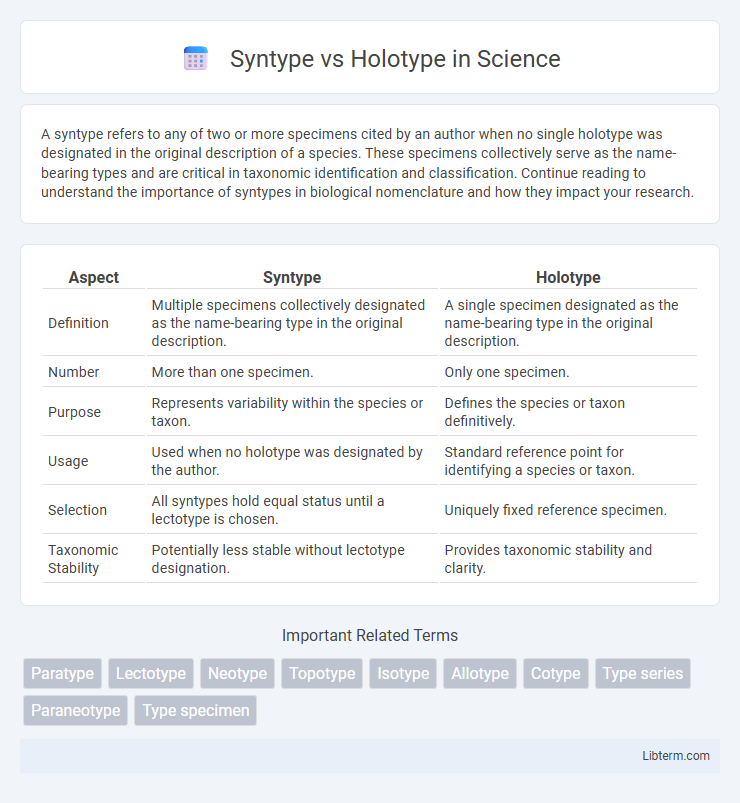A syntype refers to any of two or more specimens cited by an author when no single holotype was designated in the original description of a species. These specimens collectively serve as the name-bearing types and are critical in taxonomic identification and classification. Continue reading to understand the importance of syntypes in biological nomenclature and how they impact your research.
Table of Comparison
| Aspect | Syntype | Holotype |
|---|---|---|
| Definition | Multiple specimens collectively designated as the name-bearing type in the original description. | A single specimen designated as the name-bearing type in the original description. |
| Number | More than one specimen. | Only one specimen. |
| Purpose | Represents variability within the species or taxon. | Defines the species or taxon definitively. |
| Usage | Used when no holotype was designated by the author. | Standard reference point for identifying a species or taxon. |
| Selection | All syntypes hold equal status until a lectotype is chosen. | Uniquely fixed reference specimen. |
| Taxonomic Stability | Potentially less stable without lectotype designation. | Provides taxonomic stability and clarity. |
Introduction to Biological Nomenclature
Holotype refers to the single specimen designated by the original author as the name-bearing type of a species in biological nomenclature, serving as the definitive example for identification and classification. Syntypes are multiple specimens cited in the original description when no holotype was designated, collectively representing the species' characteristics. The distinction between holotype and syntypes is crucial for taxonomic clarity and stability in naming organisms.
Defining Syntype and Holotype
A holotype is a single physical specimen designated by the original describer as the definitive example of a species, serving as the primary reference point for its identification and classification. Syntypes comprise multiple specimens cited in the original description when no holotype was designated, collectively representing the species' defining characteristics. The holotype provides a clear taxonomic anchor, while syntypes require subsequent selection of a lectotype to stabilize nomenclature.
Historical Development of Type Concepts
The historical development of type concepts in taxonomy began with the establishment of the holotype as a single, definitive specimen that anchors the name of a species, ensuring stability and clarity in classification. Syntypes emerged in cases where multiple specimens were simultaneously designated to represent a species before the widespread adoption of the holotype concept, reflecting earlier, less standardized naming practices. Over time, the formalization of the holotype system by the International Code of Zoological Nomenclature has reduced reliance on syntypes, promoting consistency in species identification and nomenclatural precision.
The Role of Types in Taxonomy
Holotypes serve as the single, definitive specimen anchoring the name of a species, ensuring precise identification and stability in taxonomy. Syntypes, a group of specimens cited when no holotype was designated, collectively represent a species but can cause ambiguity without a designated lectotype. The role of these types is crucial in taxonomy for maintaining nomenclatural consistency and facilitating accurate species classification and comparison.
Differences Between Syntype and Holotype
A holotype is a single specimen designated by the original author as the definitive example of a species, serving as the primary reference for identification. Syntypes consist of multiple specimens collectively used when no holotype was designated, representing the species without a singular reference point. The key difference lies in the singularity of the holotype versus the plurality of syntypes, impacting taxonomic clarity and stability.
Examples of Syntypes and Holotypes
A holotype is a single specimen designated as the name-bearing type of a species, such as the holotype of *Panthera leo* housed at the Natural History Museum, London. Syntypes are multiple specimens collectively designated as the name-bearing type, like the syntypes of *Brassica oleracea* described by Linnaeus, which include several plants from his original collection. These examples highlight that holotypes provide a definitive reference, while syntypes represent a series of specimens used before holotype designation was standardized.
Importance of Type Selection in Species Identification
The distinction between syntype and holotype is crucial in species identification, as a holotype serves as the single, definitive specimen representing a species, providing clarity in taxonomic reference. When no holotype is designated, syntypes collectively represent the species, which can lead to ambiguity and challenges in accurate identification. Precise type selection ensures consistency in taxonomy, aiding researchers in maintaining stable and universally accepted species names.
The Process of Lectotype Designation
The process of lectotype designation involves selecting a single specimen from the original syntype series to serve as the definitive name-bearing type when no holotype was initially designated. This selection stabilizes the species name by providing a clear reference point for identification and comparison. The lectotype is typically chosen based on the completeness, condition, and representativeness of the specimen relative to the original description.
Implications for Taxonomic Revisions
Syntypes represent multiple specimens cited when no single holotype was designated, often leading to ambiguity in species identification and complicating taxonomic revisions. Holotypes serve as a single, definitive specimen that anchors the species name, providing clarity and stability in taxonomy. During taxonomic revisions, reliance on syntypes may necessitate neotype designation to resolve inconsistencies, whereas holotypes streamline species delimitation and nomenclatural accuracy.
Best Practices in Type Specimen Preservation
Best practices in type specimen preservation emphasize maintaining holotypes in climate-controlled environments to prevent deterioration and ensure long-term stability of primary reference material. Syntypes require meticulous labeling and storage protocols to preserve their collective taxonomic significance, including detailed metadata and proper sealing to avoid contamination. Digitizing holotypes and syntypes with high-resolution imaging enhances accessibility while minimizing physical handling risks.
Syntype Infographic

 libterm.com
libterm.com